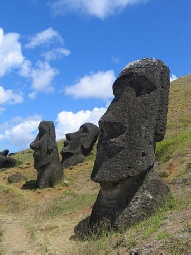© paperbacKnow limited 2013 -






The Walking Stone Heads of Easter Island
Easter Island is one of the most remote inhabited islands on Earth. It was given the name by Jacob Roggeveen who discovered it on Easter Sunday 1722. The locals, whose ancestors had (of course) discovered it many hundreds of years earlier, call it Rapa Nui.
The island is famous for its giant stone heads . Most, in fact, have substantial torsos although in many cases, these are below the ground. They are known to the locals as Moai.
. Most, in fact, have substantial torsos although in many cases, these are below the ground. They are known to the locals as Moai.
The Moai were quaried from volcanic rock at a central location and then transported all over the island. This presents us with an all-
So how did they do it?
We have, of course, the usual options of aliens. Technologically, that is a possibility. But it seems a rather trivial end to a significant endeavour. To travel half way across the universe to a distant and unknown planet; to find the most remote location possible; and to carve some stone heads and distribute them around a single island? Such shenanigans would probably not be high on NASA’s agenda if it found a habitable planet. But if it were, perhaps as a demonstration of their abilities, we might suppose that a civilisation capable of flying half way across the universe would demonstrate this capability by flying a stone head half way around the planet.
There being no evidence of Moai beyond Rapa Nui itself, I think we might rule out the possibility of involvement by third parties from beyond the island. Indeed, we have only to look at the broken Moai which lie abandoned part way to their destinations for confirmation that these great megaliths were moved along the ground. Conventional wisdom has, for many years, assumed that the Moai were moved on wooden rollers made from the trees that once covered the island. This fits into the ecocide theory in which the island’s civilisation, in its ambition to create these magnificent monuments, completely deforested their habitat to the extent that their survival was no longer viable. That is an interesting story that I will consider another day.
The oral tradition of the Rapa Nui themselves, however, claims that the Moai walked to their destinations.
Now that’s maybe not the first thing that comes to mind when you think of moving large objects. But the idea of thousands of men pulling at a vast array of ropes is somewhat complex. And we have the recent evidence of Ed Leedskalnin and Wally Wallington to show us that large and heavy objects can be successfully moved by a lone individual. So could these giant stones really have walked? Clearly not on their own, but with a bit of help…
The Archaeologists Investigated
In the first place, they had an oral tradition that the Moai had walked to their locations. This is perhaps not conclusive of itself. But Two Pennorth believes that such oral traditions are rarely completely invented. Normally they are founded in truth.
So the archaeologists looked again at the Moai -
Think about that for a moment. If your challenge is to move a really large heavy object a significant distance, wouldn’t you start by seeing if there was anything you could do to make it lighter? It seems too obvious an alternative to have been simply overlooked. They weren’t simply moving whole blocks and shaping them on arrival. The Moai were substantially shaped at the quarry -
That sounds silly. But when the archaeologists examined the Moai in more detail -
Needless to say, they gave it a go. They found that a relatively small number of people with a small amount of rope could move a large Moai in this way.
The detractors say that it’s not so easy. While this works on flat ground, it would not be so easy on rough terrain. But they could, of course, have planned their route in advance. And there is, in any case, plenty of evidence that many of the Moai did not make it to their destination. Plenty lie broken by the wayside.
This video shows the experimental walking Moai.